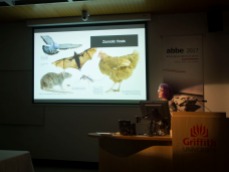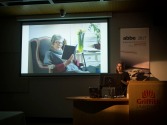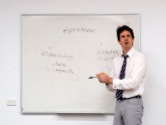Posts Tagged ‘Clyde McGill’
PERFORMING the BOOK @ SLQ – Siganto Artists Book Seminar
The Siganto Artists’ Books Seminar 2015
On June 20+21 the 2015 The Siganto Artists’ Books Seminar took place at the State Library of Queensland. Attendees were presented with a one–day series of lectures, performances and a forum addressing the diversity of the artists’ book and importantly visual and creative research being undertaken by Fellowships supported by the Siganto Foundation.
The State Librarian Jeanette, introduced by MC Christene Drewe, spoke of the Library’s Artists’ Book Collection. This was followed by Dr Marie Siganto from the Siganto Foundation who spoke enthusiastically about the Foundation’s support of the Artists’ Book Collection.
A significant theme of this years’ event was based around the idea of artists’ books as performance. Brazilian artist, performer and academic Amir Brito Cadôr’s presented his keynote address The Book as Performance – he also performed a book reading of Momento Vital by Brazilian artist Vera Chaves Barcellos.
In the morning session 2015 Siganto Foundation Artists’ Books Fellows Clyde McGill and Julie Barratt presented progress reports on their research projects. Jan Davis discussed her 2014 Creative Fellowship and presented the completed artists’ book to the Library. The book was entitled Drawing on the ground and referenced the historical aspects of work and toil on Queensland farms. Reference material for Jan’s book came from diaries, books and documents held by the Library. Her artists’ book features text fragments and line sketches – the book was bound by Fred Pohlman and the cover was styled to resemble an old station journal.
As the 2014 Siganto Artists’ Books Research Fellow I presented an illustrated lecture on my experiences as a researcher of the Australian Library of Art, a selection of the range of books I encountered that employed photography from very minor references in text to conceptual pieces based on photographs. This list included:
Anne Wilson in, Tock 01-01-2000, 2000
Codex Event: Darren Bryant .. [et al.], Wild Cherry Tin Mine, 2006.
Vince Dziekian, Blooms Books, 1993-4.
Barbara Davidson, Different moods of the Opera House, 2001.
Felipe Ehrenberg, Generacion 1973
Peter Kingston, The Blue Mountains, 1987.
Michael Buhler, Oblique Lines, 19-.
William Copley Notes on a Project for a Dictionary of Rediculous Images, 1972.
Adam Broomberg + Oliver Chanarin, Holy Bible, 2013.
Judy Barrass, Eden-Monaro in Summer, 2001.
Juli Haas, The oyster book of lessons from the memory room, 2007.
Jihad Muhammad aka John Armstrong, Ten menhirs at Plouharnel, Carnac, Morbihan, Bretagne, France, 1982.
Angela Callanan, 7 Signs of Absence, 2010.
Susan King, Photo bio, 2011.
Malcolm Enright, Western Wisdom, 1998.
Pierre Cavalan, Artists Book, 1998.
Compiled by Kay Faulkner Indulge, 2006.
Debra Gibson, Kamikaze, 2004.
Dick Jewell, Found Photos, 1977.
Julie Barratt, Collateral damage, 2008.
Alison Knowles, Bread and Water, 2004.
David King, Raw deal, 1997.
Valerie Keenan HY1, 2001.
Tim Johnson, Fittings, 1972.
Christian Boltanski, Scratch, 2002.
Amanda Watson-Will, Judy and the Jacaranda, 2010.
Phillip Zimmerman, High tension, 1993.
Jan Davis, Solomon, 1995.
I then disclosed the principal research product the paper: The artists’ book, the photobook and the photo-a spectral approach, as well as recommendations to the Library for photobooks to be relocated from the General collection into places that reflected the significance of these books in the history of photography and the photobook. I also supplied Photobook Publishers and Info URLs that could be used by anyone wanting to keep up with new photobook releases an purchasing opportunities. I particularly noted that the Library held no Trent Parke books and provided, as an example, his book Dream Life that could have been purchased in 2000 for around $60 is now sold for $1,000+. Highlighting the need for the SLQ to be pro-active in purchasing contemporary book for modest outlay – rather than waiting until they are nearly unaffordable. I also highlighted the need for institutions to engage with and maintain links with artists’ book and photobook self-publishers as they exist outside of the usual publishing structures. I quoted Des Cowley, the State Library of Victoria’s History of the Book Manager from a statement made by him in his presentation at the ‘Other Photobook’ forum at Photobook Melbourne. He said:
… It is therefore incumbent upon staff in these institutions to build networks and relationships with the communities creating this work in order to be informed about what is being produced, and to ensure this material is acquired and preserved for future researchers.
My presentation concluded with two quotes from book artist and mail art aficionado Ulises Carrion that I felt related to the contemporary artists’ book and photobook. Carrion states:
I include books in the category of
living creatures … : they grow, reproduce, change colour, become ill and finally die.
At this moment we are witnessing the final stage of this process.
… if books are to survive they have to change. And [artists’] bookworks is the real possibility that books have for survival.
Schraenen, G. (1992). Ulises Carrion : We have won! Haven’t we?
.
HERE IS THE SLQ VIDEO OF THE SIGANTO FELLOW’S PRESENTATIONS
.
Other artists’ book performances included: Virginia and Julie Barratt’s The Morning After, one by Clyde McGill and a performance by QUT drama students of the three-part book Robert Bringhurst’s artist’s book New World Suite number three: a poem in four movements for three voices. The performers were Thomas Yaxley, Emily Weir and Meghan Clarke and was directed by QUT lecturer Floyd Kennedy.
The afternoon concluded with a forum moderated by Louise Martin-Chew on the topic of collaboration. The forum participants were Clyde McGill, Julie Barratt and Doug Spowart. Each participant discussed a project that involved collaboration and questions were posed by Louise to bring out important points from each panelist. The most interesting aspect of this forum was when questions from the floor created heated debate around the idea of the physical book and its experience verses the virtual online experience.
On Sunday many local and interstate stallholders presented their work for an Artists’ Book Fair in the Knowledge Walk at the SLQ. Tours of selected artists’ books from State Library’s Artists’ Book Collection were well attended and provide rare access to special books from the Australian Library of Art Collection. The two-day event was significant for the opportunity for artists’ book aficiandos, makers, collectors and readers to engage with the physicality of not only the books but also to touch with the extensive community of the book. Our thanks must go to the SLQ, particularly Christene Drewe and Helen Cole, and to the Dr Marie Siganto and the Siganto Foundation for their continued support of the artists’ book collection of the Australian Library of Art and events such as these. Doug Spowart
What follows are a range of images from the Seminar and Artists’ Book Fair
Presented by SLQ with the generous support of the Siganto Foundation. All photos and text ©2015 Doug Spowart














































































